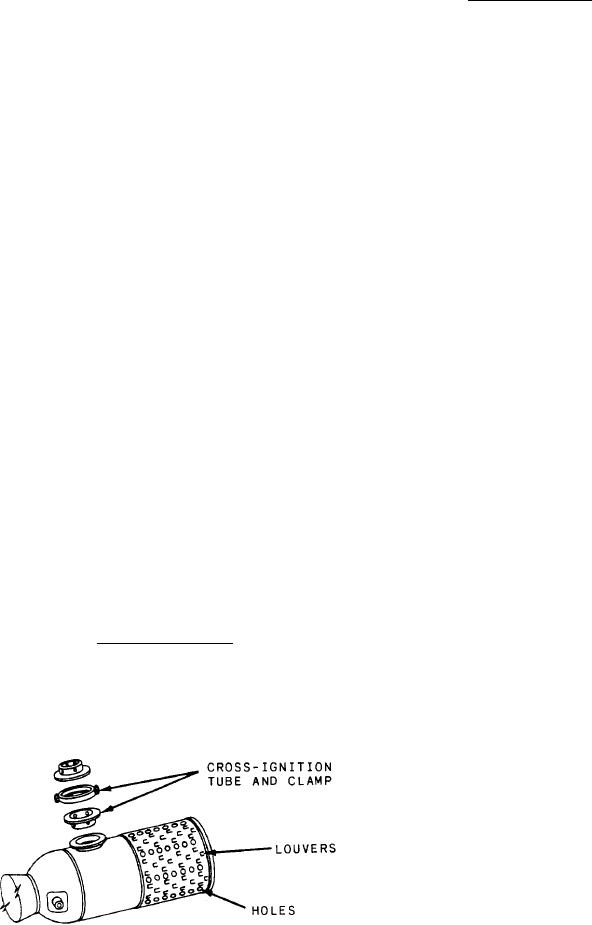
ignition, and a fuel drainage system to drain off
dome. When internal mounting at the liner dome,
the chamber cover is removed for replacement or
unburned fuel after engine shutdown.
maintenance of the nozzle.
The three basic types of combustion chambers
The simplex nozzle, with its single orifice, does
are as follows:
not provide a satisfactory spray over a wide range
1. The multiple chamber, or can
of operating conditions. Therefore, its use on
2. The annular, or basket
current models of jet engines is limited.
The duplex nozzle has good spray character-
3. The can-annular
istics. Its use does require a pressurizing valve
Can Type
(flow-divider) to divide flow to the primary and
main fuel manifolds. During starting and idling,
The can-type combustion chamber is typical
the small primary orifice of the duplex nozzle
provides a high degree of atomization under low
of the type used on axial-flow engines. Can-type
pressures. As sufficient pressure builds, the
combustion chambers are arranged radially
around the axis of the engine. The amount of
pressurizing valve opens the main line; the larger
chambers will vary in number. In the past (or
orifice supplies increased fuel in a atomized form.
Newer engines use single-or multiple-unit duplex
development years) as few as 2 and as many as
nozzles for satisfactory sprays under various
16 chambers have been used. The present trend
shows the use of about 8 or 10 combustion
operating conditions.
The cross-ignition tubes are a necessary part
chambers. Figure 1-25 shows the liner of a can-
type combustion chamber. These chambers are
of the can-type combustion chambers. Since each
numbered in a clockwise direction. As you face
of the cans is in reality a separate burner, each
operates independently of the other. Combustion
the rear of the engine and look forward, the
number 1 chamber is at the top.
is spread during the initial starting operation by
simply interconnecting all the chambers. As the
Some provision is made in the combustion
chamber case or in the compressor air outlet elbow
flame is started by the spark igniter plugs in the
for the installation of a fuel nozzle. The fuel
two lower chambers, it passes through the tubes
nozzle delivers the fuel into the liner in a finely
and ignites the combustible mixture in the
atomized spray. The finer the spray, the more
adjacent chambers. This process, similar to the
rapid and efficient the burning process.
action of a pilot light on a gas stove, continues
The two types of fuel nozzles being used in
until all the chambers are ignited. Actually only
the various types of combustion chambers are the
a few seconds are needed for this process. Then
simplex nozzle and the duplex nozzle. The fuel
the two spark igniters are no longer needed, and
nozzles are constructed so they can be installed
they cut off automatically.
in various ways. The two methods used most
To be sure the can-annular type combustion
frequently are external mounting and internal
chambers have positive ignition during the starting
mounting. In external mounting, a mounting pad
cycle, two spark igniters are used and located in
is provided for attachment of the nozzle to the
the two lower chambers.
case or the inlet air elbow, with the nozzle tip
Another very important requirement in the
projecting into the chamber liner, usually near the
construction of combustion chambers is providing
the means for draining unburned fuel. The
drainage requirement involves many factors, such
as the prevention of residual fuel deposits (gum)
after evaporation in the fuel manifold, nozzles,
and combustion chambers. Also, if fuel is allowed
to accumulate after shutdown, an afterfire could
occur. Another possibility is at the next starting
attempt, the excess fuel in the combustion
chamber could ignite. Tailpipe temperature could
go beyond safe operating limits.
The liners of the can-type combustors
(fig. 1-25) have the usual perforations of various
sizes and shapes. Each hole has a specific purpose
and effect on the flame propagation within the
Figure 1-25.-Cars-type combustion liner.
liner. The air entering the combustion chamber
1-19

